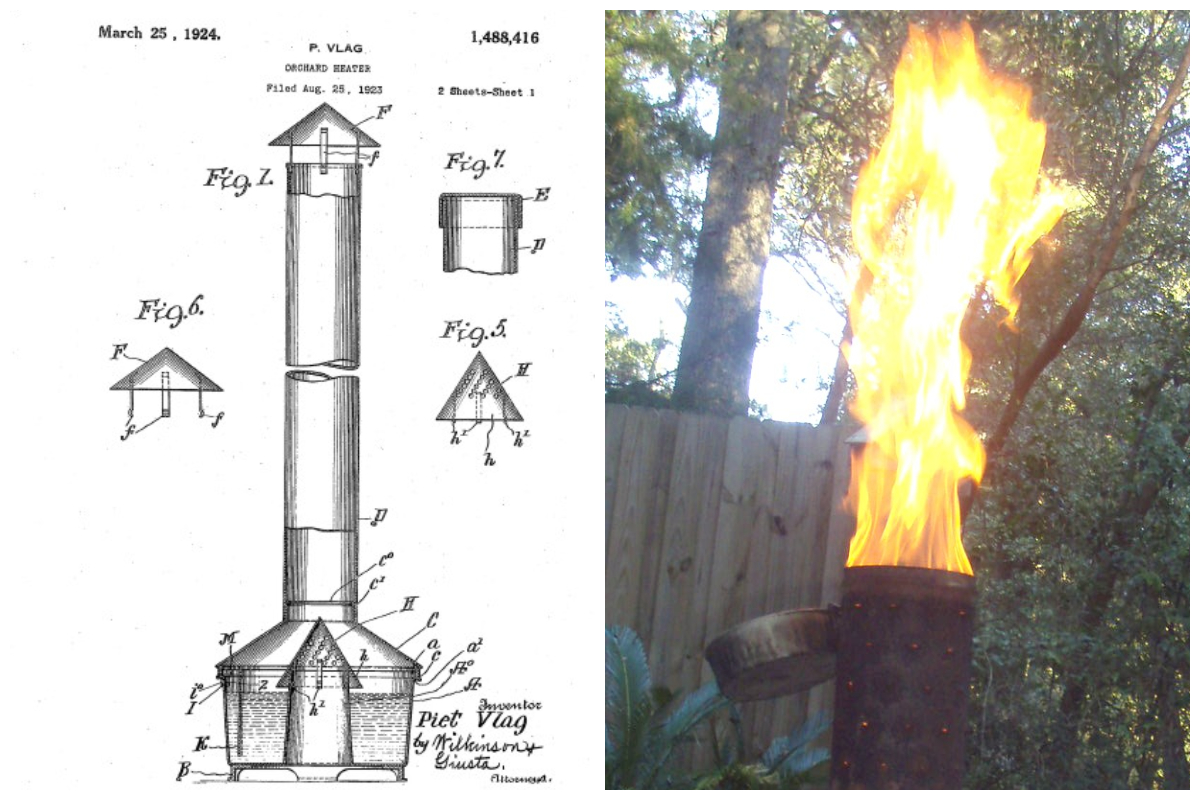A smudge pot is a relatively old invention dating back to the early 19th century. Also known as chufa or orchard heater, it is an oil-burning device designed to keep fruit trees from freezing during frost periods. A smudge pot has a large metal base with a chimney protruding from the center.
In the good old days, when fuel was cheaper, smudge pots were preferred to keep the trees warm in orchards when the cold spells made a hit. They did a pretty good job at preventing frost from accumulating on the groove of trees and damaging the tree tissue.
Smudge pots have also been valuable assets during wartime. For instance, during World War 2, they were frequently utilized by the Japanese, Germans, and the United States to provide shelter from the enemy.
The smoke emitted from these pots restricted visibility from above, thus efficiently hampering the location of a target area. In Vietnam, soldiers used smudge pots to protect against laser-guided bombs. The smoke from them would break the connection of the laser beams with their intended target by dissolving them, hence acting as a helpful defense against laser-guided bombs.
Table of Contents
What is the purpose of a smudge pot?
Before the invention of the battery-powered safety blinkers, small smudge pots served to delineate work zones on highways at night, for example, during periods of road maintenance, etc. They were used to warn and divert the ongoing traffic from these zones.
Small airports and far-off airfields without electric runway lights commonly put these oil-burning lamps to good use by using them for illumination in cases of emergency night landings.
That’s not all. Since these pots are so good at heating their surroundings, they were used routinely at construction sites to warm up the area so the workers could be more comfortable.
Even now, they continue to be of benefit in many ways. They can be a great source of warmth, whether you’re enjoying a cookout on a chilly night or a late-night swim in the pool.
Heat and warmth aren’t all that they provide. If you want to spend time outside without being bothered by pesky mosquitos, a smudge pot can come in handy! The whine of a mosquito is, quite possibly, the most annoying sound on earth.
These pesky winged insects are known to wreak havoc, especially during the night, and ruin outdoor events. All you have to do is fill your smudge pot with citronella oil, a natural mosquito-repellant. The oil will burn and effectively drive away all those maddening insects before they can make a meal out of your skin!
However, exercise caution while using citronella oil as many people happen to be allergic to it. Ask around to make sure no one’s allergic before you light up the magic lamp!
How does a smudge pot work?
Commonly placed between trees in orchards, smudge pots serve their purpose by keeping trees warm. They produce heat and smoke by burning oil, usually kerosene, but diesel fuel and sump oil are also traditional choices. The smoke from the burning oil creates a blanket above the treetops that functions to reduce heat loss and preserve as much as possible to protect the trees.
Here’s how it works:
Oil is placed inside the base of the smudge pot, making sure that it reaches the line marked on it. The wick of the pot has to be entirely immersed in oil since it has to draw fuel to create smoke.
After it has been filled with oil and the wick position checked, the smudge pot is closed.
There’s a damper on the side of the smudge pot that’s designed to draw in air.
The damper is opened by adjusting the level or turning the dial.
A flame is then created using a long-handled lighter to burn the wick. The flame lights up the pot and produces heat and smoke.
Once the air coming from the pot starts to feel warm to the touch, the damper has to be closed only partially. This is a crucial step because if the damper isn’t positioned properly, too much smoke can be produced.
Ask Away: The FAQ Section
Yes. A smudge pot may experience periodic ‘explosions’ if the damper is not closed. These are due to the release of unburnt gases in the chimney. However, these explosions are not dangerous. However, these explosions may be noisy and produce lots of smoke.
Here’s a simple explanation of how to use a smudge pot:
Always bring your smudge pot outside to light it. Place it between the trees in the area you want to heat.
Add oil to the base of your smudge pot to the line marked on it.
Ensure that the wick is covered in oil completely.
Light up the wick and wait for the oil to burn.
Smudge pots are illegal in California. Be sure to check with your local community before you decide to light one!
Oil is placed inside the base of a smudge pot and burned. Burning the oil produces heat and smoke that work to stave off a cold snap and warm the surroundings.
Typically, smudge pots burn for up to 1 liter per hour on low flame and 1 gallon an hour on high flame. Your use per hour largely depends on the kind of fuel that you use to burn your pot.
Almost any kind of combustible oil, including diesel, kerosene oil, or used sump oil, can be used to light up a smudge pot.
The use of smudge pots became widely popular in 1913 when a disastrous freeze in South California wiped out a whole crop.
In 1947, the use of smudge pots was finally outlawed, with the introduction of wind machines and other less environmentally-damaging machinery.
Since smudge pots burn oil and release large amounts of smoke and carbon dioxide into the air, they’re damaging to the environment. They also pose a risk of oil spillage and leaks.

